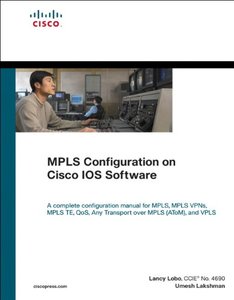MPLS Network Management: MIBs, Tools, and Techniques (Hardcover)
暫譯: MPLS 網路管理:MIB、工具與技術 (精裝版)
Thomas D. Nadeau
- 出版商: Morgan Kaufmann
- 出版日期: 2002-12-19
- 定價: $1,980
- 售價: 5.0 折 $990
- 語言: 英文
- 頁數: 525
- 裝訂: Hardcover
- ISBN: 155860751X
- ISBN-13: 9781558607514
-
相關分類:
Web-crawler 網路爬蟲、雲端運算
立即出貨
買這商品的人也買了...
-
 Linux C/C++ 網路程式設計
Linux C/C++ 網路程式設計$450$383 -
 PHP 徹底研究(新編第二版) (PHP Bible, 2/e)
PHP 徹底研究(新編第二版) (PHP Bible, 2/e)$650$507 -
 Visual Basic.NET 2003 實作進銷存系統
Visual Basic.NET 2003 實作進銷存系統$590$460 -
 鳥哥的 Linux 私房菜─基礎學習篇增訂版
鳥哥的 Linux 私房菜─基礎學習篇增訂版$560$476 -
 osCommerce 購物網站架設實戰
osCommerce 購物網站架設實戰$550$468 -
 Linux 與 Windows 共舞─異質平台整合方案
Linux 與 Windows 共舞─異質平台整合方案$650$514 -
 FreeBSD 實務手冊
FreeBSD 實務手冊$650$514 -
 JSP 2.0 技術手冊
JSP 2.0 技術手冊$750$593 -
 Linux 網路管理實務: 調校、帳號、監控、安全
Linux 網路管理實務: 調校、帳號、監控、安全$580$458 -
 FreeBSD 5.x 架設管理與應用
FreeBSD 5.x 架設管理與應用$490$382 -
 JSP 與 Servlet 500 個應用範例技巧大全集
JSP 與 Servlet 500 個應用範例技巧大全集$590$460 -
 AutoCAD 2004 & 2005 實力養成暨評量
AutoCAD 2004 & 2005 實力養成暨評量$350$277 -
 MySQL 徹底研究 (The Definitive Guide to MySQL, 2/e)
MySQL 徹底研究 (The Definitive Guide to MySQL, 2/e)$650$507 -
 PHP 5 & MySQL 程式設計
PHP 5 & MySQL 程式設計$580$493 -
 XOOPS 2 火速架站秘笈
XOOPS 2 火速架站秘笈$480$374 -
 Head First Design Patterns (Paperback)
Head First Design Patterns (Paperback)$2,550$2,423 -
 SCWCD 認證考試實作手冊 (SCWCD Exam Study Kit)
SCWCD 認證考試實作手冊 (SCWCD Exam Study Kit)$680$530 -
 實戰 Linux 防火牆:iptables 應用全蒐錄 (Linux Firewalls, 2/e)
實戰 Linux 防火牆:iptables 應用全蒐錄 (Linux Firewalls, 2/e)$580$493 -
 PHP 網頁模組隨學隨用
PHP 網頁模組隨學隨用$480$379 -
 Java 2 500 個高段應用範例技巧大全集
Java 2 500 個高段應用範例技巧大全集$580$452 -
 Fedora Core 3 Linux 實務應用 DVD版
Fedora Core 3 Linux 實務應用 DVD版$650$514 -
 ASP.NET 徹底研究進階技巧─高階技巧與控制項實作
ASP.NET 徹底研究進階技巧─高階技巧與控制項實作$650$507 -
 精通 Essential ActionScript 2.0 (Essential Actionscript 2.0)
精通 Essential ActionScript 2.0 (Essential Actionscript 2.0)$680$537 -
 Google Android SDK 開發範例大全
Google Android SDK 開發範例大全$750$638 -
 作業管理精簡版 (Stevenson/ Operations Management, 9/e)
作業管理精簡版 (Stevenson/ Operations Management, 9/e)$660$627
商品描述
Description:
MPLS-enabled networks are enjoying tremendous growth, but practical information on managing MPLS-enabled networks has remained hard to find. Until now.
MPLS Network Management: MIBs, Tools, and Techniques is the first and only book that will help you master MPLS management technologies and techniques, as they apply to classic MPLS networks, traffic-engineered networks, and VPNs. Written by the co-author of most current MPLS management standards, it provides detailed, authoritative coverage of official MIBs, examining key topics ranging from syntax to access levels to object interaction. It also offers extensive consideration of third-party management interfaces, including tools for metering traffic and predicting traffic growth and behavior. If you're a network operator, network device engineer, or MPLS application developer, you need this book to get all you can out of all of MPLS's many capabilities.
Table of Contents:
Chapter 1 Introduction
1.1 A Brief Introduction to MPLS
1.2 Applications of MPLS
1.3 Key Aspects of MPLS Network Management
1.4 Management Information Base Modules for MPLS
Interview: George Swallow
Chapter 2 Management Interfaces
2.1 The Basics of Management Interfaces
2.2 The Command Line Interface
2.3 CORBA
2.4 XML
2.5 Bulk File Transfer
2.6 The Simple Network Management Protocol (SNMP)
Interview: Arun Vishwanathan
Chapter 3 The MPLS Label Switching Router Management Information Base (MPLS-LSR MIB)
3.1 Who Should Use It
3.2 MPLS-LSR MIB at a Glance
3.3 Labels In, Labels Out
3.4 A Simple Example
3.5 The MPLS Interface Configuration Table
3.6 The InSegment Table
3.7 The MPLS OutSegment Table
3.8 The Cross-Connect Table
3.9 The Traffic Parameter Table
3.10 A Note about SNMP RowPointer Use
3.11 The Label Stack Table
3.12 Notifications
3.13 Scalability Issues with Notifications
3.14 Next Index
3.15 A Note about Indexing
Interview: Kireeti Kompella
Chapter 4 The MPLS Label Distribution Protocol MIB (MPLS-LDP MIB)
4.1 The Label Distribution Protocol
4.2 Managing LDP
4.3 Definition of Terms Used in the MIB
4.4 The LDP Identifier
4.5 LDP Entity Table
4.6 LDP Entity Configuration General Label Range Table
4.7 ATM Tables
4.8 Frame Relay Tables
4.9 LDP Entity Example
4.10 Gathering Statistics for Entities
4.11 LDP Peer Table
4.12 LDP Hello Adjacencies Table
4.13 LDP Session Table
4.14 LDP ATM Session Table
4.15 LDP Frame Relay Session Table
4.16 The LDP Session Statistics Table
4.17 The LDP Session Peer Address Table
4.18 Modification of Established LDP Sessions
4.19 Operational and Administrative Status
4.20 Mapping Tables
4.21 Cross-Connects FEC Table
4.22 Notifications
4.23 What the MIB Does Not Support
4.24 How the MIB Varies from the LDP Specification
4.25 Using the MPLS-LDP MIB with TDP
Interview: Joan Cucchiara
Chapter 5 The MPLS Forward Equivalency Class to Next-Hop Label Forward Entry MIB (MPLS-FTN MIB)
5.1 Who Should Use It
5.2 IP Traffic In, MPLS Labels Out
5.3 Forwarding Equivalency Classes
5.4 A Simple Example of FEC-to-NHLFE
5.5 MPLS FTN Table
5.6 MPLS FTN Map Table
5.7 MPLS FTN Performance Table
5.8 Another FTN Example
Interview: Bruce Davie
Chapter 6 The Interfaces MIB and MPLS
6.1 Who Should Use It
6.2 IF-MIB Overview
6.3 Evolution of the IF-MIB
6.4 Applying the IF-MIB to Classic MPLS Networks
6.5 Applying the IF-MIB to MPLS TE Networks
Interview: Adrian Farrel
Chapter 7 Offline Traffic Engineering
7.1 Traffic Engineering
7.2 Traffic Engineering in MPLS Networks
7.3 Deliberate MPLS TE Models
7.4 Tunnel Sizing
7.5 Tunnel Path Selection
7.6 Use of Offline TE for Backup Tunnels
7.7 The Traffic Engineering System
7.8 TE System Components
7.9 Input to Traffic Engineering Tools
7.10 TE Cycle Components
7.11 Offline versus Online Calculations
Interview: Ross Callon
Chapter 8 The MPLS Traffic Engineering MIB (MPLS-TE MIB)
8.1 Constraint-Based Routing
8.2 Signaling Constraint-Based Paths
8.3 MPLS-TE MIB Overview
8.4 Definition of Terms Used in the MIB
8.5 RowPointer Usage in MPLS-TE MIB
8.6 Scalars
8.7 The Tunnel Table
8.8 MPLS Tunnel Resource Table
8.9 The CR-LDP Resource Table
8.10 MPLS Tunnel Hop Table
8.11 The Actual Route Hop Table
8.12 The Computed Route Hop Table
8.13 The Tunnel Performance Table
8.14 IF-MIB Applicability
8.15 Tunnel Table and MPLS-LSR MIB Interaction
8.16 Multiple Tunnels across MPLS Network Example
8.17 Notifications
Interview: Harmen Van Der Linde
Chapter 9 NetFlow Accounting
9.1 NetFlow Overview
9.2 Flow-Based Accounting
9.3 NetFlow Architecture
9.4 NetFlow Data Export
9.5 Deploying NetFlow
9.6 NetFlow Accounting for MPLS
Interview: XiPeng Xiao
Chapter 10 Traffic Matrix Statistics
10.1 The Traffic Engineering Problem
10.2 Traffic Matrix Statistics Objectives
10.3 Traffic Engineering Domain of Interest
10.4 Traffic Characterization
10.5 Selecting Sampling Periods
10.6 Traffic Matrix Structure
10.7 Measurement Architecture Options
10.8 Cost and Performance Considerations
Interview: Danny McPherson
Chapter 11 The MPLS Virtual Private Networking MIB (PPVPN-MPLS-VPN MIB)
11.1 MPLS Virtual Private Networks (VPNs)
11.2 Definition of Terms Used in the MIB
11.3 The PPVPN-MPLS-VPN MIB at a glance
11.4 Scalar Objects
11.5 MplsVpnVrfTable
11.6 MplsVPNIfConfTable
11.7 MplsVPNPerfTable
11.8 MplsVpnVrfRouteTable
11.9 MplsVpnRouteTargetTable
11.10 MplsVpnVrfBgpNbrAddrTable
11.11 MplsVpnVrfBgpNbrPrefixTable
11.12 mplsVpnVrfSecTable
11.13 Notifications
11.14 Enterprise VPN Example
Interview: Cheenu Srinivasan
Chapter 12 Future Directions for MPLS Network Management
12.1 Generalized MPLS (GMPLS)
12.2 Pseudo-Wire Edge-to-Edge Emulation
12.3 New Developments in MPLS
12.4 IETF PPVPN Working Group VPN Management Standardization
12.5 DMTF
12.6 Concluding Remarks
Appendix A: IETF and Other Standards Bodies
Appendix B: MPLS-TC MIB
Glossary
Bibliography
Index
Concluding Remarks
Glossary
商品描述(中文翻譯)
**描述:**
啟用 MPLS 的網路正在經歷巨大的增長,但有關管理 MPLS 啟用網路的實用資訊一直難以獲得。直到現在。
《MPLS 網路管理:MIB、工具與技術》是第一本也是唯一一本幫助您掌握 MPLS 管理技術和技術的書籍,適用於經典的 MPLS 網路、流量工程網路和 VPN。這本書由當前大多數 MPLS 管理標準的共同作者撰寫,提供了官方 MIB 的詳細、權威的覆蓋,探討從語法到訪問級別再到對象互動的關鍵主題。它還廣泛考慮了第三方管理介面,包括流量計量和預測流量增長及行為的工具。如果您是網路運營商、網路設備工程師或 MPLS 應用開發人員,您需要這本書來充分利用 MPLS 的各種功能。
**目錄:**
第 1 章 介紹
1.1 MPLS 簡介
1.2 MPLS 的應用
1.3 MPLS 網路管理的關鍵方面
1.4 MPLS 的管理資訊基礎模組
訪談:George Swallow
第 2 章 管理介面
2.1 管理介面的基本概念
2.2 命令行介面
2.3 CORBA
2.4 XML
2.5 批量檔案傳輸
2.6 簡單網路管理協定 (SNMP)
訪談:Arun Vishwanathan
第 3 章 MPLS 標籤交換路由器管理資訊基礎 (MPLS-LSR MIB)
3.1 誰應該使用它
3.2 MPLS-LSR MIB 概覽
3.3 標籤進、標籤出
3.4 一個簡單的例子
3.5 MPLS 介面配置表
3.6 InSegment 表
3.7 MPLS OutSegment 表
3.8 交叉連接表
3.9 流量參數表
3.10 有關 SNMP RowPointer 使用的說明
3.11 標籤堆疊表
3.12 通知
3.13 通知的可擴展性問題
3.14 下一索引
3.15 有關索引的說明
訪談:Kireeti Kompella
第 4 章 MPLS 標籤分配協定 MIB (MPLS-LDP MIB)
4.1 標籤分配協定
4.2 管理 LDP
4.3 MIB 中使用的術語定義
4.4 LDP 識別符
4.5 LDP 實體表
4.6 LDP 實體配置一般標籤範圍表
4.7 ATM 表
4.8 幀中繼表
4.9 LDP 實體範例
4.10 收集實體的統計數據
4.11 LDP 對等表
4.12 LDP Hello 鄰接表
4.13 LDP 會話表
4.14 LDP ATM 會話表
4.15 LDP 幀中繼會話表
4.16 LDP 會話統計表
4.17 LDP 會話對等地址表
4.18 修改已建立的 LDP 會話
4.19 操作和管理狀態
4.20 映射表
4.21 交叉連接 FEC 表
4.22 通知
4.23 MIB 不支持的內容
4.24 MIB 與 LDP 規範的差異
4.25 將 MPLS-LDP MIB 與 TDP 一起使用
訪談:Joan Cucchiara
第 5 章 MPLS 前向等效類到下一跳標籤前向條目 MIB (MPLS-FTN MIB)
5.1 誰應該使用它
5.2 IP 流量進、MPLS 標籤出
5.3 前向等效類
5.4 FEC 到 NHLFE 的簡單範例
5.5 MPLS FTN 表
5.6 MPLS FTN 映射表
5.7 MPLS FTN 性能表
5.8 另一個 FTN 範例
訪談:Bruce Davie
第 6 章 介面 MIB 和 MPLS
6.1 誰應該使用它
6.2 IF-MIB 概述
6.3 IF-MIB 的演變
6.4 將 IF-MIB 應用於經典 MPLS 網路
6.5 將 IF-MIB 應用於 MPLS TE 網路
訪談:Adrian Farrel
第 7 章 離線流量工程
7.1 流量工程
7.2 MPLS 網路中的流量工程
7.3 故意的 MPLS TE 模型
7.4 隧道大小
7.5 隧道路徑選擇
7.6 將離線 TE 用於備份隧道
7.7 流量工程系統
7.8 TE 系統組件
7.9 流量工程工具的輸入
7.10 TE 週期組件
7.11 離線與在線計算
訪談:Ross Callon
第 8 章 MPLS 流量工程 MIB (MPLS-TE MIB)
8.1 基於約束的路由
8.2 訊號約束路徑
8.3 MPLS-TE MIB 概述
8.4 MIB 中使用的術語定義
8.5 MPLS-TE MIB 中的 RowPointer 使用
8.6 標量
8.7 隧道表
8.8 MPLS 隧道資源表
8.9 CR-LDP 資源表
8.10 MPLS 隧道跳數表
8.11 實際路由跳數表
8.12 計算路由跳數表
8.13 隧道性能表
8.14 IF-MIB 的適用性
8.15 隧道表與 MPLS-LSR MIB 的互動
8.16 跨 MPLS 網路的多個隧道範例
8.17 通知
訪談:Harmen Van Der Linde
第 9 章 NetFlow 計費
9.1 NetFlow 概述
9.2 基於流的計費
9.3 NetFlow 架構
9.4 NetFlow 數據導出
9.5 部署 NetFlow
9.6 MPLS 的 NetFlow 計費
訪談:XiPeng Xiao
第 10 章 流量矩陣統計
10.1 流量工程問題
10.2 流量矩陣統計目標
10.3 流量工程的關注領域
10.4 流量特徵化
10.5 選擇取樣週期
10.6 流量矩陣結構
10.7 測量架構選項
10.8 成本和性能考量
訪談:Danny McPherson
第 11 章 MPLS 虛擬私人網路 MIB (PPVPN-MPLS-VPN MIB)
11.1 MPLS 虛擬私人網路 (VPN)
11.2 MIB 中使用的術語定義
11.3 PPVPN-MPLS-VPN MIB 概覽
11.4 標量對象
11.5 MplsVpnVrfTable
11.6 MplsVPNIfConfTable
11.7 MplsVPNPerfTable
11.8 MplsVpnVrfRouteTable
11.9 MplsVpnRouteTargetTable
11.10 MplsVpnVrfBgpNbrAddrTable
11.11 MplsVpnVrfBgpNbrPrefixTable
11.12 mplsVpnVrfSecTable
11.13 通知
11.14 企業 VPN 範例
訪談:Cheenu Srinivasan
第 12 章 MPLS 網路管理的未來方向
12.1 一般化 MPLS (GMPLS)
12.2 假線路邊到邊的模擬
12.3 MPLS 的新發展
12.4 IETF PPVPN 工作組 VPN 管理標準化
12.5 DMTF
12.6 總結
附錄 A:IETF 和其他標準組織
附錄 B:MPLS-TC MIB
詞彙表
參考文獻
索引
總結
詞彙表




















